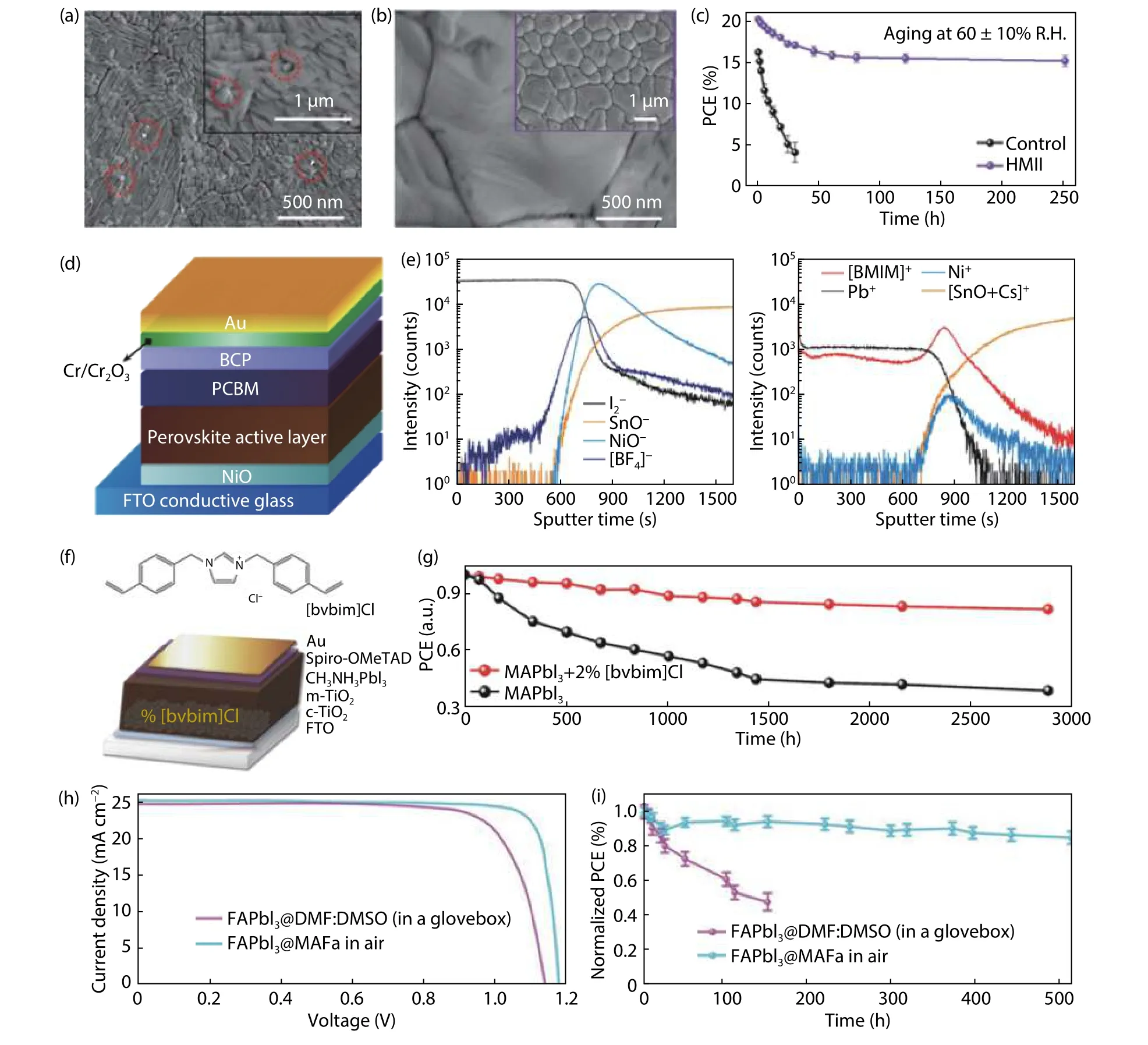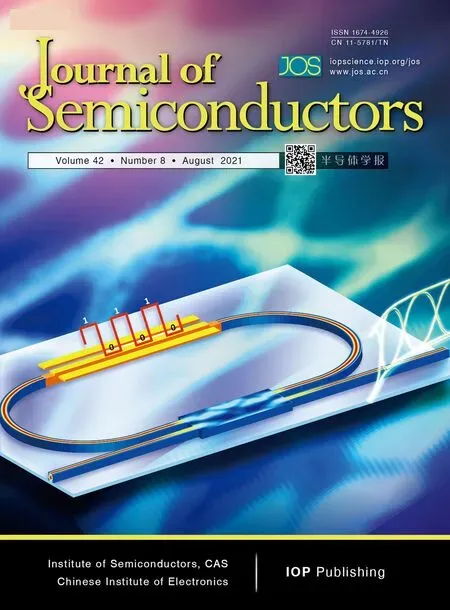Ionic liquids in perovskite solar cells
2021-08-26WensiCaiZhigangZangandLimingDing
Wensi Cai, Zhigang Zang,, and Liming Ding
1Key Laboratory of Optoelectronic Technology & Systems (MoE), Chongqing University, Chongqing 400044, China
2Center for Excellence in Nanoscience (CAS), Key Laboratory of Nanosystem and Hierarchical Fabrication (CAS), National Center for Nanoscience and Technology, Beijing 100190, China
Metal halide perovskites have gained a lot of attention particularly in recent years due to their excellent optoelectronic properties and simple scalable processability[1−3].One major application of halide perovskites is solar cells, however, despite the power conversion efficiencies (PCEs) have already reached around 25%[4,5], the long-term stability issue of such devices still impedes their commercialization.Ionic liquids,which contain a large asymmetric organic cation and an organic or inorganic anion, have recently been applied to perovskite solar cells (PSCs), not only increasing the efficiency but also remarkably improving the long-term stability[6,7].
While the addition of ionic liquids into transport layers and/or at transport layer/perovskite interfaces could improve energy level alignment and passivate interface defects[8,9],the addition of them into perovskite precursors might control the crystallization dynamics of perovskite films.For example, Huanget al.incorporated methylammonium acetate(MAAc) into the precursor solution of MAPbI3, which formed an intermediate phase called MAPbI3–xAcxand slowed down the reaction between MAI and PbI2in the solution to manage the crystal growth[10].Besides, the MAAc additive was found to induce a crystalline reconstruction of MAPbI3from(110)/(002) planes to (112)/(200) planes[11].By precisely controlling the content of MAAc, PbI2could preferentially crystallize in a (101) phase, inducing a reconstruction of PbI6octahedral framework during annealing and resulting in dense perovskite films with large grains along (112)/(200) planes.
Similarly, Sonmegogluet al.employed an ionic liquid, 1-hexyl-3-methylimidazolium iodide (HMII), to avoid the easy phase change of FAPbI3from blackα-phase to yellowδphase[12].Owing to the high polarity and high boiling-point of HMII, the liquid domains between neighboring grains are yielded and the activation energy of the grain-boundary migration is reduced, resulting in a grain coarsening of FAPbI3crystals and micron-sized grains with reduced parasitic traps(Figs.1(a) and 1(b)).This effective trap passivation also suppresses non-radiative recombination and improves overall charge-carrier dynamics, leading to an efficiency of 20.6%and an increase of open-circuit voltage by 80 mV compared with HMII-free ones.Most importantly, the HMII treatment also improves the device stability under both high humidity and thermal stress, retaining >80% of their initial efficiencies under 60 ± 10% relative humidity (RH) and ~95% at 65 °C, respectively (Fig.1(c)).
The improvement of efficiency and long-term stability were also reported by Snaithet al., who incorporated BMIMBF4into perovskite precursors (Fig.1(d))[13].While BF4–anions are found mainly located at the buried interface, the BMIM+cations exist not only at the buried interface but also throughout the whole film, suggesting an accumulation of ion pairs of BMIM+and BF4–at the perovskite/NiO interface(Fig.1(e)).The accumulation of BMIM+cations at the surface and grain boundaries of the perovskite film could suppress the degradation of perovskites and improve the film stability.As a result, the PSCs show aJ–V-derived efficiency degradation of only 5% even after being aged under full-spectrum sunlight at 70–75 °C for more than 1800 h.
Owing to the easy decomposition in air, hybrid perovskites are usually prepared in a dry or inert environment,which increases the manufacturing cost.By incorporating ionic liquids with hydrophobic groups, the humidity sensitive issue of perovskites could be overcome by the molecular encapsulation.Recently, Dysonet al.reported that a self-polymerizing hydrophobic ionic liquid, called 1,3-bis(4-vinylbenzyl)imidazolium chloride ([bvbim]Cl) (Fig.1(f)), can effectively improve the moisture resistance of perovskites, enabling them to be made under humid environment while still maintaining a high device performance[14].During the crystallization of the perovskite film, the added [bvbim]Cl formed an insoluble and hydrophobic cross-linked polymerviaself-polymerization, which effectively reduced the moisture sensitivity during device fabrication and yielded a decent PCE of 19.9% for FAMAPbI3solar cells made under ~50% RH.Such ionic liquids were also applied to MAPbI3solar cells, which showed an improved long-term stability with >80% of their initial performance maintained even after being stored in air for more than 2900 h (Fig.1(g)).
Ionic liquids can also be used to replace traditional solvents.Recently, Huanget al.reported that by substituting traditional DMF:DMSO with an ionic liquid called methylamine formate (MAFa) to prepare precursor solutions, they made stableα-FAPbI3films regardless of humidity and temperature[15].While PbI2@DMF:DMSO thin films have a random orientation distribution and hence an energy barrier to formαphase FAPbI3, the excellent vertically oriented crystallization of PbI2@MAFa thin films enabled the quick entering of FA+into the interior crystals and a rapid reaction between FA+and PbI2to produce stableα-phase FAPbI3.Besides, the strong Pb···O and hydrogen-bond interactions between residual MAFa and PbI2framework prevented the film decomposition.As a result, the device performance was dramatically im-proved (Fig.1(h)), showing a PCE of 24.1%.Moreover, even the unencapsulated FAMAPbI3@MAFa cells could maintain 80% and 90% of their initial efficiencies for 500 h at 85 °C(Fig.1(i)) and under a continuous light stress, respectively,demonstrating the great potential of this approach.

Fig.1.(Color online) SEM micrographs for FAPbI3 films (a) without and (b) with HMII.(c) Stability curves for the devices aged under ambient conditions (25 °C, 60 ± 10% RH).Reproduced with permission[12], Copyright 2021, Wiley-VCH.(d) The structure for a p–i–n solar cell.(e) ToF-SIMS depth profiles for BMIM-BF4-containing perovskite film on an NiO/FTO glass substrate.Reproduced with permission[13], Copyright 2021, Nature.(f)[bvbim]Cl (top) and the PSC (bottom).(g) Device stability study.The cells were stored in air (50% RH, room temperature).Reproduced with permission[14], Copyright 2021, Wiley-VCH.(h) J–V curves for champion cells based on FAPbI3@MAFa and FAPbI3@DMF:DMSO films.(i) Thermal stability comparison between two unencapsulated devices under continuous heating at 85 °C in a N2 glovebox.Reproduced with permission[15], Copyright 2021, Science.
The above research and results clearly demonstrate the effectiveness of ionic liquids in performance enhancement of perovskite solar cells.However, deep understanding on solution chemistry as well as the effects of residual ionic liquids in perovskite films is still required in order to design more versatile ionic liquids and further improve the device performance.
Acknowledgements
W.Cai and Z.Zang thank National Natural Science Foundation of China (11974063), Key Program of Natural Science Foundation of Chongqing (cstc2020jcyj-jqX0028), China Postdoctoral Science Foundation (2020M683242), and Chongqing Special Postdoctoral Science Foundation(cstc2020jcyj-bshX0123) for financial support.L.Ding thanks National Key Research and Development Program of China(2017YFA0206600) and National Natural Science Foundation of China (51773045, 21772030, 51922032, 21961160720) for financial support.
杂志排行
Journal of Semiconductors的其它文章
- Reliability evaluation on sense-switch p-channel flash
- I mpact of switching frequencies on the TID response of SiC power MOSFETs
- Targeted transfer of self-assembled CdSe nanoplatelet film onto WS2 flakes to construct hybrid heterostructures
- First-principles study of the growth and diffusion of B and N atoms on the sapphire surface with h-BN as the buffer layer
- Low-cost dual-stage offset-cancelled sense amplifier with hybrid read reference generator for improved read performance of RRAM at advanced technology nodes
- Ultra-low Vpp and high-modulation-depth InP-based electro–optic microring modulator
